
Petersham is a village in the London Borough of Richmond upon Thames on the east of the bend in the River Thames south of Richmond, which it shares with neighbouring Ham. It provides the foreground of the scenic view from Richmond Hill across Petersham Meadows, with Ham House further along the river. Other nearby places include Twickenham, Isleworth, Teddington, Mortlake, and Roehampton.

The London Borough of Richmond upon Thames in southwest London, England, forms part of Outer London and is the only London borough on both sides of the River Thames. It was created in 1965 when three smaller council areas amalgamated under the London Government Act 1963. It is governed by Richmond upon Thames London Borough Council and is divided into nineteen wards. The population is 198,019 and the major settlements are Barnes, East Sheen, Mortlake, Kew, Richmond, Twickenham, Teddington and Hampton.
Richmond is a town in south-west London, 8.2 miles (13.2 km) west-southwest of Charing Cross. It stands on the River Thames, and features many parks and open spaces, including Richmond Park, and many protected conservation areas, which include much of Richmond Hill. A specific Act of Parliament protects the scenic view of the River Thames from Richmond.
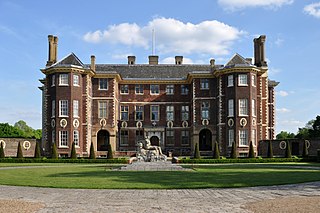
Ham is a suburban district in Richmond, south-west London. It has meadows adjoining the River Thames where the Thames Path National Trail also runs. Most of Ham is in the London Borough of Richmond upon Thames and, chiefly, within the ward of Ham, Petersham and Richmond Riverside; the rest is in the Royal Borough of Kingston upon Thames. The district has modest convenience shops and amenities, including a petrol station and several pubs, but its commerce is subsidiary to the nearby regional-level economic centre of Kingston upon Thames.
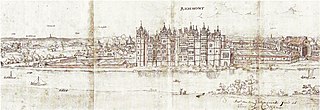
Richmond Palace was a Tudor royal residence on the River Thames in England which stood in the sixteenth and seventeenth centuries. Situated in what was then rural Surrey, it lay upstream and on the opposite bank from the Palace of Westminster, which was located nine miles (14 km) to the north-east. It was erected in about 1501 by Henry VII of England, formerly known as the Earl of Richmond, in honour of which the manor of Sheen had recently been renamed "Richmond". Richmond Palace therefore replaced Shene Palace, the latter palace being itself built on the site of an earlier manor house which had been appropriated by Edward I in 1299 and which was subsequently used by his next three direct descendants before it fell into disrepair.

Richmond Green is a recreation area near the centre of Richmond, a town of about 20,000 inhabitants situated in south-west London. Owned by the Crown Estate, it is leased to the London Borough of Richmond upon Thames. The Green, which has been described as "one of the most beautiful urban greens surviving anywhere in England", is roughly square in shape and its open grassland, framed with broadleaf trees, extends to roughly twelve acres. On the north-east side there is also a smaller open space called Little Green. Richmond Green and Little Green are overlooked by a mixture of period townhouses, historic buildings and municipal and commercial establishments including the Richmond Lending Library and Richmond Theatre.

Glover's Island is a small island in a tree-lined section of the Thames River, formerly known as Horse Reach on the tidal Thames, between Richmond Lock and Teddington Lock in the Borough of Richmond upon Thames, London, England.

Wick House is a Grade II listed house in Petersham, London, located near the corner of Nightingale Lane and Richmond Hill. The painter Sir Joshua Reynolds commissioned the house from Sir William Chambers and it was completed in 1772.

Sudbrook Park in Petersham was developed by John Campbell, 2nd Duke of Argyll in the early 18th century. Sudbrook House, designed for Argyll by James Gibbs and now Grade I listed by Historic England, is considered a fine example of Palladian architecture. The house and its surrounding park have been the home of the Richmond Golf Club since 1891.
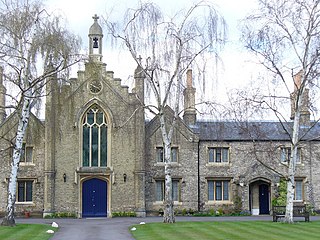
Hickey's Almshouses are almshouses between Sheen Road and St Mary's Grove in Richmond, London.
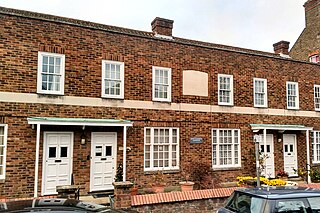
Queen Elizabeth's Almhouses are almshouses in Richmond, London, founded by Sir George Wright in 1600 to house eight poor aged women. Known originally as the "lower almshouses", they were built in Petersham Road, a few hundred yards south of what is now Bridge Street. By 1767, they were almost derelict. In 1767, William Turner rebuilt the almshouses on land at the top end of his estate in The Vineyard. Funds for the rebuilding were raised by public subscription. The almshouses were rebuilt again in 1857. They were damaged during World War II and replaced with four newly built houses in 1955.
Halford House is a Grade II listed building in Halford Road, in the centre of Richmond in the London Borough of Richmond upon Thames. Originally an 18th-century manor house with 19th-century additions, it was purchased by the Christian Fellowship in Richmond in 1954. It previously housed the Richmond School of Music.

Clarence House, Richmond is a Grade II listed house in The Vineyard, Richmond, dating from about 1696.

Ham Common is an area of common land in Ham, London. It is a conservation area in, and managed by, the London Borough of Richmond upon Thames. It comprises 48.69 hectares, the second largest area of common land in the borough, 2 acres (0.81 ha) smaller than Barnes Common. It is divided into two distinct habitats, grassland and woodland, separated by the A307, Upper Ham Road. It is an area of ecological, historical and recreational interest, designated a Local Nature Reserve.

Bishop Duppa's Almshouses, Richmond are Grade II listed almshouses in Richmond, London. They were founded by Brian Duppa, Bishop of Winchester, in 1661 to house ten unmarried women aged over 50.

Vineyard Passage Burial Ground is a cemetery on Vineyard Passage in Richmond in the London Borough of Richmond upon Thames. Established in 1790 and consecrated in 1791, it was enlarged in 1823. The last burials were in 1874. Managed by Richmond upon Thames Council and maintained by volunteers from the Environment Trust for Richmond upon Thames, it is now a garden of rest.
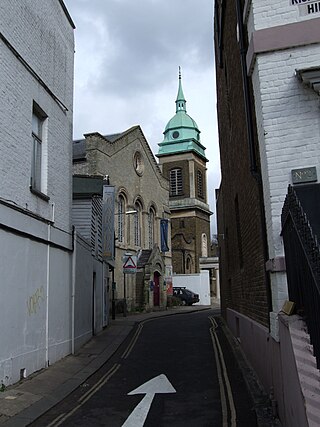
The Vineyard is a street in Richmond, in the London Borough of Richmond upon Thames. It includes three groups of almshouses, a Grade II listed church and Clarence House, a 17th-century Grade II listed house associated with Bernardo O’Higgins, who is commemorated on the wall of the property with a blue plaque, installed by English Heritage, for his role in the Chilean War of Independence.





















